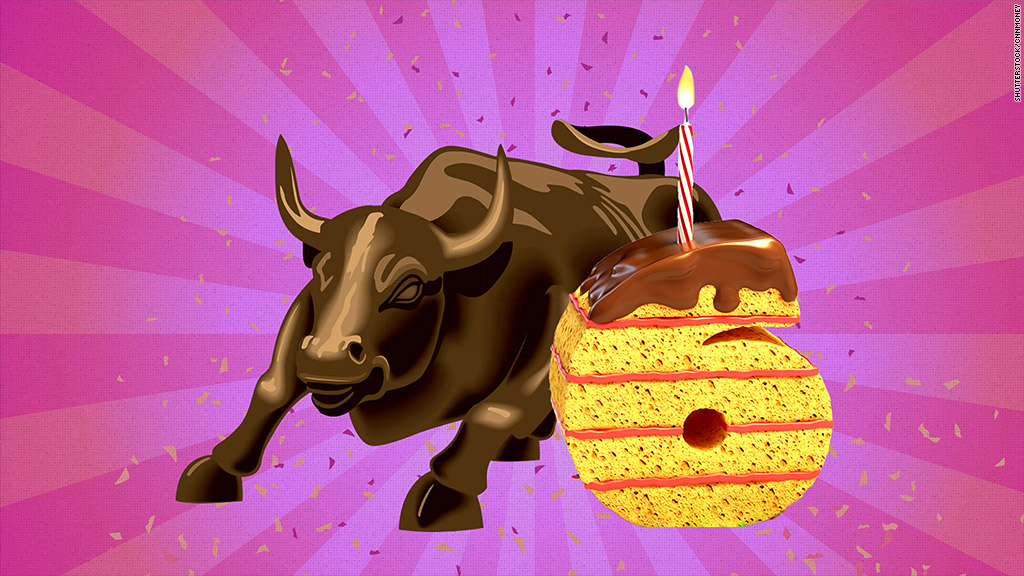
Imagine celebrating your birthday by listening to nonstop talk about your demise.
Such is life for the bull market in stocks, which officially turns six years old this week.
Rather than focusing on the 200% surge in the stock market, investors are far more concerned about whether or not the incredible run in stocks will live to see its seventh birthday.
The biggest threat to the bull market is likely the Federal Reserve raising interest rates.
Stocks tumbled on Friday -- just days after the Nasdaq recaptured the 5,000 level for the first time in 15 years -- as investors bet a surprisingly strong February jobs report increases the chances of a Fed hike in June. In other words, good news was suddenly bad, for the market at least.
Related: President Obama called stock market bottom in 2009
"The S&P 500 awoke with a hangover from post-Nasdaq euphoria, then succumbed to a case of job jitters," Sam Stovall, chief investment strategist at S&P Capital IQ, wrote in a research note on Monday.
So why is Wall Street losing sleep over a measly rate hike?
1) The end of easy money: Raising interest rates is like removing the punch bowl from the stock market party. One of the drivers of the bull market has been the Fed's policy of near zero rates since 2008.
Those emergency actions pushed investors into riskier and riskier assets by making the alternatives look less attractive. Remember, cash earns virtually nothing in the bank and bond yields are extremely low, so investors flocked to stocks.
Related: The bull market in stocks is six years old. Now what?
2.) Historical red flags: If you look at history, investor concerns about rate hikes have some merit. Since World War II there have been 16 cycles during which the Fed has boosted interest rates. The risks are particularly acute when the Fed first raises rates.
During the six months before or after the first rate hike, the S&P 500 experienced a decline of 5% or more 13 times, according to Stovall.
That means over 80% of the time, the stock market suffered a blow when the Fed raised rates.
Related: The best six stocks from the bull market
Is the market handcuffing the Fed? Some investors already fear a negative reaction this time around. The Dow plunged 279 points on Friday in response to the unemployment rate dropping to a seven-year low.
While the market rebounded a bit on Monday, continued turmoil in the stock market could actually handcuff the Fed.
"If this action continues, the FOMC is less likely to move. The Fed plays the stock market. Let's not pretend it doesn't," Michael Block, chief market strategist at Rhino Trading, wrote in a note to clients.
He pointed to how back in October when the stock market began tumbling St. Louis Fed President James Bullard suggested the central bank could extend its bond-buying program. Investors seized on the comments even though the Fed ultimately did end quantitative easing.
"This is how the Fed rolls these days," Block wrote.
Related: Nasdaq dogs: Cisco and Yahoo got left behind
Correction is overdue: Assuming the Fed actually does go forward with a rate hike in June or later in the year, how will the market react?
History isn't as clear on the gravity of the downturns after the Fed starts lifting interest rates. There's been a wide range of negative reaction in the stock market, including three bear markets where stocks fell at least 20%. The stock market also experienced two pullbacks (declines of at least 5% but less than 10%) and two corrections of 10% or more.
Stovall believes a bear market is unlikely, especially because the U.S. economy looks healthy, corporate earnings continue to grow and stocks still look better than alternatives.
But it's clear a correction is long overdue. The S&P 500 hasn't suffered a decline of 10% or more in more than four years (since October 2011). Normally that happens once every year and a half.
A correction could be scary for investors, but it might actually be a healthy thing for the long term. It would allow cash sitting on the sidelines to enter at a more attractive price level and ease concerns that stocks have become too expensive.
On average it takes the S&P 500 just four months to get back to breakeven following a correction, according to Stovall.
"While it may be advisable to brace for a correction, one should also prepare for a recovery in what could ultimately allow this sixth year bull celebrate its seventh anniversary," he wrote.


